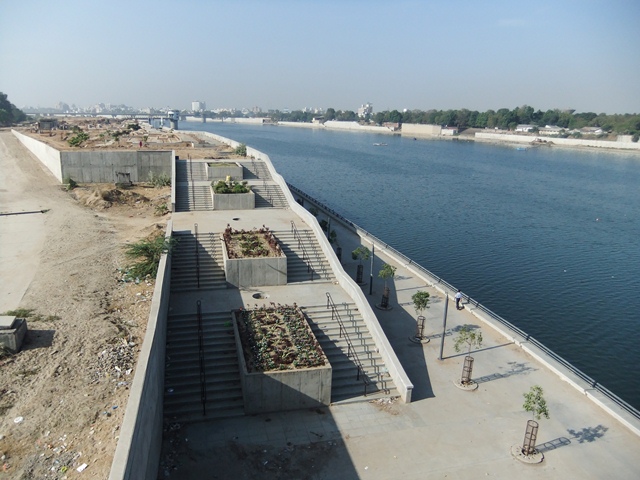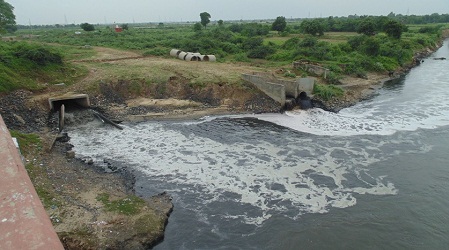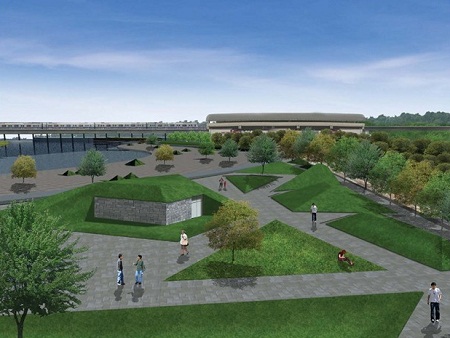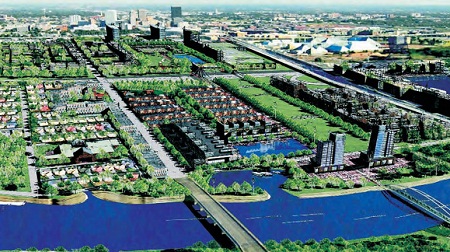There is a rush of riverfront development schemes in India. We have heard of Sabarmati Riverfront Development being drummed many times, followed by the proposed rejuvenation of Ganga and Yamuna, supposedly on the lines of Sabarmati.
What does riverfront development entail? Is it river restoration? Are the millions of rupees spent on riverfront development schemes justified? Will it help in saving our damaged rivers?
A cursory glance at the existing river restoration/ improvement/beautification schemes indicates that the ‘rejuvenation’ discourse in the country revolves mainly around recreational and commercial activities. It is more about real estate than river. Concrete wall embankments, reclamation of the riverine floodplains and commercialisation of the reclaimed land are innate components of these projects.
Activities promoted on riverfronts typically include promenades, boat trips, shopping, petty shops, restaurants, theme parks, walk ways and even parking lots inside encroached river beds!
This kind of riverfront development essentially changes the ecological and social scape of the river transforming it into an urban commercial space. Is it wise to go for this kind of development on riverfronts? What does it do to the river ecosystem, its hydrological cycle? These questions need to be explored before accepting the current model of riverfront development as either replicable or laudable.
Sabarmati Riverfront Development Project: Reclaim and beautify!
The Sabarmati Riverfront Development in Ahmedabad city, supposed to be designed on the lines of the Thames in London or Seine in Paris, was projected as a pioneering project in riverfront development.

The concrete banks of Sabarmati River. Pic: Alex Follmann
The project was proposed by Environmental Planning Collaborative, an Ahmedabad-based urban planning consultancy firm in 1997. The riverfront on either side of the Sabarmati for 10.4 kms was proposed to be developed, reclaiming about 185 ha of land by constructing embankments and roads, laying water supply lines and trunk sewers, building pumping stations, and developing gardens and promenades. Construction of the project started in 2005.
The mainstay of the project was the sale of riverfront property. 21 per cent of the 185 ha of reclaimed land which was developed by concretising the river bank was sold to private developers for commercial purpose. Activities hosted on this reclaimed land were recreational and commercial activities in restaurants, shops, waterfront settlements, gardens, walkways, amusement parks, golf course, water sports etc. Some part of it was utilised for public purpose, such as roads.
The sale of reclaimed land created by the project is expected to cover the full cost of the project. The project was implemented through a Special Purpose Vehicle called the Sabarmati Riverfront Development Corporation Ltd. The project cost was estimated to be in the range of Rs 11,520 million. Around two thirds of this amount has already been spent.
Even though the project has been modeled as one of “best practice” by several financing institutions, it has also drawn severe criticism for poor rehabilitation of the displaced disrupting the nexus of shelter, livelihood and services of urban poor, lack of transparency in the execution and for tampering with the carrying capacity of the river.
No Environment Impact Assessment of the project has been conducted nor any credible public consultation process held.
Sabarmati channel has been uniformly narrowed to 275 metres during the riverfront development project from its natural width of about 350 metres, minimum width being 330 metres. In this attempt of “pinching the river”, the original character of the river has changed completely from a seasonally flowing river to an impounded tank.
The water impounded in this stretch is not even Sabarmati’s water, but rather the waters of the Narmada, on which the city of Ahmedabad or Sabarmati has no right. This water was justified and meant for the drought prone areas of Kutch, Saurashtra and North Gujarat.
In the entire process, there has been no cleaning of the river either. The project has only transferred the polluted water, carrying untreated sewage and toxic effluents from Ahmedabad city and district industries to the river downstream from Vasna barrage.

Sewage entering the Sabarmati, downstream of Vasna barrage. Pic: Alex Follmann
Impacts
The reclaimed land and the narrowing of the channel have adversely affected the carrying capacity of the river. The project was stalled during August 2006 to March 2007 due to heavy floods. Prior to the floods, the river's maximum carrying capacity had been calculated at 4.75 lakh cusecs on the basis of rainfall over the last 100 years. The floods however proved the calculation wrong.
The National Institute of Hydrology and the Indian Institute of Technology Roorkee re-evaluated the project design. Their report said "the calculations did not take into account any simultaneous rainfall over the entire catchment area". The report also states that riverfront development is "not a flood control scheme", and that the municipal corporation will have to work out other measures to meet the impending challenge of floods.
The project has also been heavily criticised for the poor rehabilitation of the evicted slum population. A Public Interest Litigation was filed in the Gujarat High Court by the Sabarmati Nagarik Adhikar Manch, supported by several other non-governmental organisations to ensure justice and bring transparency to the process.
According to the High Court orders, at least 11,000 affected families were to be rehabilitated and resettled by the Ahmedabad Municipal Corporation. Over 3,000 people have been moved to a marshland in the outskirts of the city with negligible compensation, little and infrequent access to drinking water and minimal sanitation facilities.
The Yamuna: Can one imperfect project inspire another?
Many rivers like the Yamuna, Ganga, Mithi, Brahmaputra etc. are now proposed to be ‘developed’ on the lines of the Sabarmati by different government agencies.
Recently, the newly-elected BJP-led Central Government sent a team of bureaucrats to Gujarat to study the feasibility of replicating the Sabarmati Riverfront Development Project for cleaning the Yamuna. Despite the concerns about the flooding of the Yamuna, the team is exploring ways of replicating the Sabarmati Model.
Reclaiming the floodplains to create a concrete riverfront, as in Ahmedabad, could be ecologically unsound and even dangerous for Delhi which is already vulnerable to floods. In fact the Inter-governmental Panel on Climate Change put Delhi amongst the three cities at highest risk of floods, globally. The sediment load in Yamuna is very high and the non-channelised river rises by over four metres during peak monsoon flooding. Risk of flooding will increase several fold for a channelised river.
An expert committee appointed by the Ministry of Environment and Forests to examine the Yamuna River Front Development Scheme of the Delhi Development Authority recommended scrapping of the ambitious plan for developing recreational facilities, parking lots and promenades. The committee was formed following an order from the National Green Tribunal, drawn in response to a petition filed by activists and Yamuna Jiye Abhiyaan convener Manoj Misra.
The committee pointed out that recreational spots located in active floodplain areas would kill the river and would reduce its flood-carrying capacity, increasing flooding and pollution.

A schematic drawing for Yamuna riverfront prepared by design firm named Morhogenesis, which has been engaged by the Shahjahanabad Redevelopment Corporation.
The city of Noida however has decided to go ahead with the Rs 200-crore Yamuna Riverfront Development Project that Greater Noida Authority has planned. The project involves developing recreational facilities like parks, yoga centres, picnic spots and sports centres, polo grounds, golf course etc. on Hindon and Yamuna floodplains. Here again, the project has nothing to do with sustaining, cleaning, rejuvenation of the river.
Spare the Ganga!
The National Ganga River Basin Authority was shifted from the environment ministry to the water resources ministry recently. The new name for the Ministry of Water Resources is Ministry of Water Resources, River Development and Ganga Rejuvenation. Prime Minister Narendra Modi assigned the specially-created ministry for cleaning the Ganga to Uma Bharati, who was quoted in print media as saying, “If Sabarmati can be cleaned, all other rivers can also be made better.”
But what Uma Bharati seems to have missed is that the Sabarmati has NOT been cleaned, it has merely transferred the polluted water downstream of the 10.4 km stretch. So, can the Sabarmati model be replicated at Ganga? And even if it is replicated, will it help the cause or the river or river rejuvenation?
A number of apprehensions have been raised in this regard. “The so-called Sabarmati model won't work for the Ganga. The Sabarmati has neither been cleaned nor rejuvenated," Himanshu Thakkar, SANDRP told Openindia News. He further points out that the Sabarmati Model survives on water from the Narmada canal in Ahmedabad city, which would not be possible in the case of Ganga.
The priority for river rejuvenation is restoring its water quality, freshwater flow and not riverbank beautification. More than Rs 20000 crore have been spent on cleaning the Ganga in the past 28 years under the Ganga Action Plan. Even so, the water quality in the Ganga has declined to the extent that it is now unfit even for irrigation or bathing.
The count of harmful organisms, including hazardous faecal bacteria, at many locations is more than 100 times the limit set by the government. The water's biochemical oxygen content, which is vital for the survival of aquatic wildlife, has dipped drastically. Any “cosmetic treatments” will not work for Ganga, just as they have not worked for Sabarmati.
More about real estate than rivers
While there are experts opposing replication of Sabarmati Riverfront Project on Ganga and Yamuna River, there are several other riverfront projects which are inspired by the Sabarmati Project and which are being pushed without any kind of studies or impact assessment.
The Brahmaputra Riverfront Development Project is an example. While on one hand Guwahati is struggling to cope with the flood prone nature of the Brahmaputra River, the Assam government plans to implement ‘Brahmaputra Riverfront Development Project’ through the Guwahati Metropolitan Development Authority (GMDA). The foundation of the project was laid by the Chief Minister Tarun Gogoi in February 2013.
The project plans to achieve maximum possible reclamation.The project plan talks of revitalisation of the river ecology and strengthening of riverbanks through soil bio-engineering on one hand, and on the other inducts several urban features on its agenda such as a promenade, ghats, plazas and parks, conference facilities, parking lots, infrastructure for floating restaurants, and many others.
Will such scale of real estate development leave any room for the river or its revitalisation?
Again,the Technical Bid Document released by the Lucknow Development Authority for the Gomti Riverfront Development Project in Lucknow has no component of water treatment or river restoration, even as it projects a landscape-based development project, which will also look at “reclaiming” the river banks for activities like shops, entertainment area, promenades, etc. Neither is there any mention of maintaining adequate flow in Gomti, treating its sewage, conserving its floodplains, or any other ecological angles.
The Pune Municipal Corporation, already noted for chronically polluting the Mula and Mutha rivers flowing through the heart of the city, has sanctioned the Pune Riverfront Project, under the aegis of the Jawaharlal Nehru National Urban Renewal Mission). The project envisages channelising the river, introducing barrages to maintain water levels, introducing navigation, development of the riparian zone as entertainment and shopping areas, parking lots and so on.
This “improvement” project has not taken into consideration the once-in-a-hundred-years-flood in Pune, even as it plans to constrict the river further, thus encroaching upon the riverbed. Creation of stagnant pools through barrages will result in backwater effect on the many nallahs that join the river. These Nallahs routinely flood the adjoining areas during the rainy season and additional backwater in these nallahs will worsen the situation further.
The project also does not say a word about treating water quality, but envisages building drainage lines inside the riverbed and carrying the sewage out of Pune city limits. This hardly qualifies as river rejuvenation or restoration. A case has been filed against this project in the National Green Tribunal.
In the Goda Park (Godavari Riverfront Project) in Nashik, Maharashtra, the Nashik Municipal Corporation (NMC) has been hankering after beautification of Godavari’s banks through laser shows, musical fountains, rope-way, multi-purpose meeting hall, garden, water sports, canteens etc., ignoring the pressing issues of water quality. The project has been handed over to the Reliance Foundation by NMC without any public consultation or discussions.
Even after the catastrophic floods of 26 July 2005, when the Mithi river flooded some of the most densely populated areas claiming nearly 1000 lives, the Municipal Corporation of Greater Mumbai (MCGM) and Mumbai Metropolitan Region Development Authority (MMRDA) have made a plan to “restore” the river.
The Mithi Riverfront Development involves desilting, beautification and building of a retaining wall. MMRDA has planned to beautify the stretch of 1.5 km (10 Ha) which lies right amidst mangroves by developing a promenade on a PPP (Public Private Partnership) basis. Interestingly, the Mukesh Ambani-led Reliance Foundation and Standard Chartered bank have been selected for this project.

Schematic drawing for Mithi Riverfront prepared by the Observer Research Foundation.
This project also falls in the Coastal Regulation Zones (CRZ) II and III. The CRZ authority in its 82nd meeting refused to allow any reclamation or construction activities in this stretch and has asked MMRDA to take prior permission of High Court if the proposal involves destruction of mangroves.
The real impact of urbanising rivers
Evidently, all riverfront projects discussed above are essentially bank beautification and real estate development projects having little to do with restoration of the river. There is neither social or environmental impact assessment, nor regulation or democratic and participatory decision making process in the riverfront projects.
Such projects aim at commodifying rivers to develop urban scapes; they ignore the ecological as well as social setting of Indian rivers and the fact that challenges here are significantly different from the foreign models that we are aspiring to emulate. A blind replication will result in further degradation of the rivers and wastage of public funds, benefitting real estate players and a section of the urban middle class alone.
At the same time, none of the models seem to borrow the increasingly eco-centric view of river restoration in the west wherein rivers are given more room to flow, and river restoration is akin to riparian restoration and de-channelisation. River pollution governance is exemplary there, storm water is retained and recharged through innovative measures like storm water parks or green sponge areas and urban communities constitute an important stakeholder in the process.
It is time to recognise that our rivers too need genuine rejuvenation rather than ‘riverfront’ development. Trying to impose cosmetic layers on deeper wounds wrought by drying up, encroachment, pollution and real estate development will achieve nothing.
REFERENCES
- Sabarmati's sorrow
- AMC bets on huge returns from riverfront property sale
- On the Sabarmati Riverfront
- Socialising a River and Inclusive Development
- Concerns over Sabarmati Riverfront Development Project
- River front Development Ahmedabad
- Flood control in Sabarmati a challenge for AMC
- Delhi babu all praise for Sabarmati plan
- River experts say Sabarmati no model for Yamuna
- Scientist cautions against riverfront plan
- Scientist opposes Sabarmati model, says reclaiming floodplain not a good idea for Yamuna
- Yamuna Action Plan soon Promises MoEF
- Twin cities to go ahead with riverfront project
- NGT Order on Yamuna Riverfront Development
- PM Modi heads superbody to drive Mission Ganga
- Cleaning up the Ganga, Yamuna: Why Modi must forget Sabarmati model
- Sabarmati model not enough for Ganga
- Rejuvenating a River
- Guwahati: CM Lays Foundation of Beautification
- Govt. to Develop City Riverfront in Guwahati
- Brahmaputra Riverfront Development: Pradeep Sachdeva Associates
- Lucknow Development Authority to get new blueprint of Gomti riverfront development project
- Akhilesh wants 'London Eye' in Lucknow
- Reliance Foundation Urban Renewal
- Goda park project to be developed by Reliance Foundation
- ORF Foundation: Making Mithi, A River Again
- Beautification plans of Mithi river promenade stuck over CRZ norm
- Minutes of 82 Meeting of Maharashtra Coastal Zone Management Committee
- Najeeb Jung: The man who may run Delhi
- Making a Sewer: A River Again Report by ORF
























